#The United Irishmen Rebellion
Text
#OTD in 1754 – Birth of Dr. William Drennan in Belfast; physician, poet, educationalist political radical and one of the chief architects of the Society of United Irishmen.
#OTD in 1754 – Birth of Dr. William Drennan in Belfast; physician, poet, educationalist political radical and one of the chief architects of the Society of United Irishmen.
William Drennan’s poetic output included some powerful and moving pieces. He is chiefly remembered today for “Erin” written in 1800, in which he penned the first reference in print to Ireland as “The Emerald Isle”:
“Nor one feeling of vengeance presume to defile
The cause, or the men, of the Emerald Isle.”
Drennan came to national attention with the publication in 1784 and 1785 of his Letters of…

View On WordPress
#Belfast#Chief Architect of The United Irishmen Society#Co. Antrim#England#Ireland#physician#Poet#The Emerald Isle#The United Irishmen Rebellion#Wake of William Orr#William Drennan
10 notes
·
View notes
Note
Hi! So this is gonna sound weird, but I’ve kinda been learning about Irish history backwards? Like, I started with the Troubles (bc of family involvement), then back to the 1916 rising which got me more interested in the people involved which took me further back and etc etc. I know I’ve been doing it “wrong” but I’m just starting to come up to the 1798. Do you happen to have any recommended readings or particular persons of interest to read? Any collections of primary sources would be more than welcome!
Secondary sources I would recommend:
The Year of Liberty by Thomas Pakenham - about the rebellion in general
The People's Rising by Daniel Gahan - about the rebellion in Wexford
The Summer Soldiers by ATQ Stewart - about the rebellion in Ulster
Wolfe Tone: Prophet of Irish Independence by Marianne Elliott - about Wolfe Tone
The Life and Times of Mary Ann McCracken by Mary McNeill - technically this is just about Mary Ann but I think it's pretty good for Henry Joy McCracken too because there aren't many biographies of him
Orangeism in Ireland and Britain 1795 - 1836 by Hereward Senior - obviously exercise caution on whether or not you think you can mentally handle this subject but book about loyalism during 1798
Castlereagh: War, Enlightenment, and Tyranny by John Bew - about Lord Castlereagh
2 things that I would also recommend reading about for context are the French Revolution and the British radical movement of the late 18th century. for the French Revolution 1 book I would say is good is Liberty or Death by Peter McPhee and for the British radical movement... the book The English Jacobins by Carl B Cone does a good enough job
Primary sources:
The Memoirs of Theobald Wolfe Tone by Theobald Wolfe Tone - title is pretty self explanatory. It's Tone's account of his own life + his diary
The United Irishmen, Their Lives and Times by RR Madden - this is considered to be the 1st history of the rising & was written with the help of many people who lived through it, so it includes a lot of first hand accounts. HOWEVER. beware that Madden was your archetypical mid 19th century Catholic Irish nationalist and the bias created due to that shows through in every single part of these books
Memoirs of the different Rebellions in Ireland by Sir Richard Musgrave - this is another very early history of the rising, also written with the help of people who lived through, also including a lot of first hand accounts. HOWEVER. Musgrave is like Madden's Orange counterpart in that this book is also wildly biased and should also be read with a degree of caution
Personal Narrative of the "Irish Rebellion" of 1798, Sequel to Personal Narrative of the "Irish Rebellion" of 1798, and History and Consequences of the Battle of the Diamond by Charles Hamilton Teeling - 3 accounts of politics in Ireland in the 1790s written by someone who as a young man led the Catholic paramilitary the Defenders
The Drennan letters (a collection of letters that Belfast doctor William Drennan and his sister, Martha McTier, wrote to each other between the 1770s and 1820s), if you can find them, are another great primary source on both the United Irishmen & on what life was like back then in general, as are the McCracken letters, which I know are available free online somewhere I just can't remember where exactly I got the pdf from
There are a lot of them but if you're interested in primary sources you might also read some of the political pamphlets/books that were going around back then -- the most famous that come to mind in this context are Wolfe Tone's Argument on Behalf of the Catholics in Ireland, Thomas Paine's The Rights of Man, and Edmund Burke's Reflections on the Revolution in France but there are wayyy more than that and at least some of them are on the internet archive
194 notes
·
View notes
Text
1798–Battle of Oulart Hill

The Battle of Oulart Hill takes place in Wexford, Ireland; Irish rebel leaders defeat and kill a detachment of militia.
0 notes
Text
youtube
#peter paul and mary#the rising of the moon#folk music#Irish resistance#Irish rebellion of 1798#name of 98#United Irishmen#Youtube
1 note
·
View note
Text
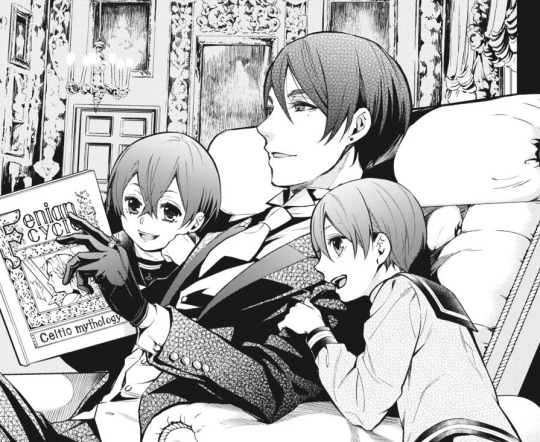
Let's talk about the "Fenian brotherhood" theory !! :D
Firstly, in case you don't know about it, please go read the theory that our!Ciel's birth name might be Fenian/Fionn/Finnian by @azuresins. It is incredibly relevant to what I'm about to explain next !
TBH, I don't really care about discovering our!Ciel's birth name. However, I truly enjoy this theory and I think it makes a lot of sense, because I absolutely agree with the idea of Vincent supporting (secretly or not) Irish independence, turning him into a political enemy of Queen Victoria...
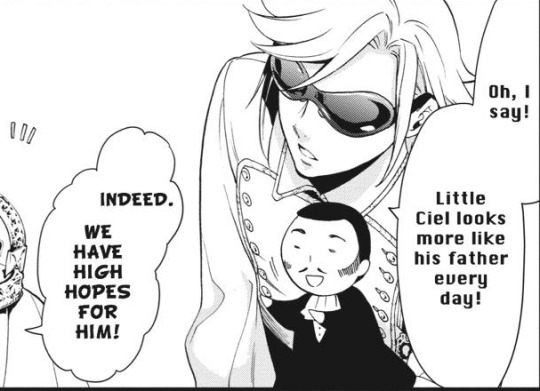
...which could be very much why he ended up dead.
This theory comes from a private convo with my friend, @dorkshadows and I'll sum up their thoughts (and some of mine) below the cut !
First of all, while we think Claudia, Vincent's predecessor, may have been a personal enemy of Victoria because of whatever happened when Albert died in 1861, Vincent strikes us more as a political enemy precisely because of Brown's comment in ch108.
After all, if our!Ciel, who just managed to thwart their plans of getting the sulin gas, is "more like his father everyday", then it makes sense that Vincent "got in the way" of some of Victoria & JB's war/political plans too. >_>
Now, about the Fenian Cycle book: it was an important symbol for Irish independence and the Fenian Brotherhood that started in the 19th century before it got dissolved in 1880. To quote Wikipedia:
"The Fenian Brotherhood traced their origins back to 1790s, in the rebellion, seeking an end to British rule in Ireland initially for self-government and then the establishment of an Irish Republic. The rebellion was suppressed, but the principles of the United Irishmen were to have a powerful influence on the course of Irish history."
But how would Vincent even get involved with it and why?
In the theory that OC's name is Fenian/Finnian, @azuresins mentioned that maybe it's all related to Cedric K. Ros having Celtic origins. Since we do have one sketch by Yana of one twin bringing the Fenian Cycle book to the Undertaker (the most likely candidate for Cedric K. Ros)...

...it might indeed be a partial answer.
There is another possibility though, entirely thought by @dorkshadows, which is that Rachel (and Ann) might have been of Irish origins too.
After all, a common stereotype for Irish people in many stories is red hair and it's hard to forget that it was a very distinctive characteristic of Ann, Rachel's sister !
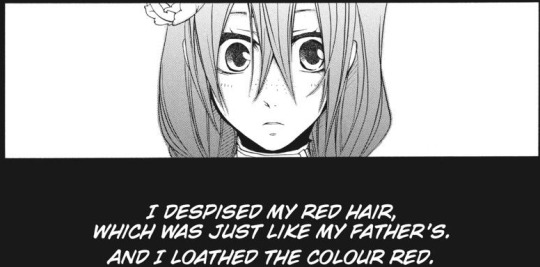

In fact, one of their first interactions is Vincent telling Ann to be proud of that hair, which we were told she inherited from her dad, the twins' maternal grandfather.
So Vincent might have not just been talking about Ann's hair color in that scene, but more specifically about her taking more pride in her Irish origins. Obviously though, Dalles/Durless aren't very Irish names, but it is possible that their original family name got anglicized into a more traditionally English name.
In any case, Vincent met Rachel and Ann after already knowing their father :
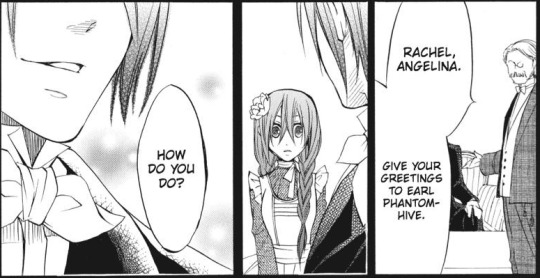
So it's possible that Vincent was, as the Watchdog, investigating Lord Durless as a nobleman with Irish lineage and possible ally of the Fenian Brotherhood. After all, to quote this article, "the Fenians in England and the British Empire were a major threat to political stability". Then Vincent met and fell in love with Rachel, thus deciding to support the Brotherhood instead.
I'd add that Vincent supporting such a cause simply makes sense, considering that the Phantomhive family, too, might have been burdened by the Watchdog's duty generations ago, because of their "different" lineage (full theory here). On top of that, if you add the possibility that Cedric/UT also was of Celtic origins (many decades or centuries ago) and that Vincent knew Claudia's death was Victoria's fault, it only makes sense that he'd eventually politically antagonize the Queen (both for his parents' sake and for Rachel's).
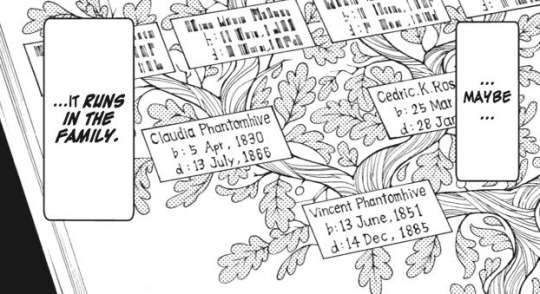
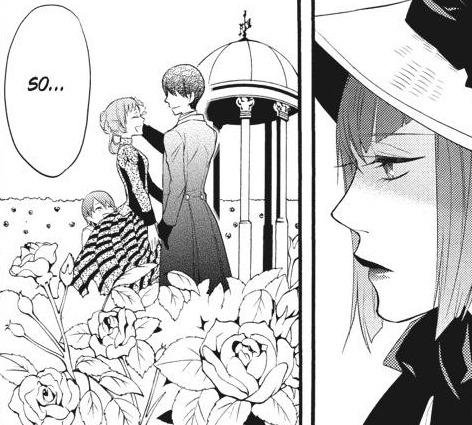
@dorkshadows also pointed out that, to this day, we don't know if the twins' maternal grandfather is alive or dead in canon : he was important enough to be mentioned in Red's flashback but has been missing from the narrative ever since. Timeline-wise, he could be dead, especially since we never saw him in the Blue Memory arc (our!Ciel's flasback), but we never know with Yana (look at Claudia being hinted in panels ever since the circus arc and probably being incredibly relevant), so it's worth keeping in mind.
Then, moving on to ch132 we know that, when the twins were born, Rachel is the one who named them.
Coincidentally (read: it's probably not a coincidence xD), ch132 had the cover with Vincent reading the Fenian Cycle book to the twins and it's also the chapter in which Vicar Rathbone casually says that one twin/both twins (it's deliberately ambiguous in Japanese) have a name that is "rare for England" :

Many fans, myself included, thought that "Ciel" was the name being discussed there, but maybe they were actually talking about our!Ciel's celtic birth name ! To quote @azuresins, in that case that'd basically mean that, in that scene above, "Vincent said to an ENGLISH PRIEST [...] that people of Celtic origin deserved freedom, and to be treated better and that it probably was soon to come".
No wonder that Vicar Rathbone would immediately change the topic lmao ! xD

Vicar Rathbone be like

It is also very meaningful that Rachel decided to give the "Fionn/Fenian/Finnian" name to our!Ciel ("the spare"), as if to emphasize that he was free to make his own path in life, as the second son, unburdened by earldom. Choosing such a meaningful name might even be a parallel to Vincent's own situation with Frances as his spare, since both also have names with a meaning relating to victory and freedom.
Another important detail, as @azuresins already explained here, is that Fenian Cycle is also a tale of revenge and that our!Ciel parallels Fionn big deal, making it all even more relevant. And maybe Yana left other hints in her artworks too...

Finally, historically the Fenian Brotherhood officially got dissolved around 1880 (the twins were 5 years old), but it's always possible that, in Kuroverse, Vincent managed to make it thrive secretly as the Watchdog. The Fenian Brotherhood caused several incidents, including after 1880 (they assassinated a British Chief Secretary in 1882), so it wouldn't be impossible that the Queen eventually found out that Vincent didn't properly take care of them, because he was supporting them.
And when she found out? Well, she branded Vincent a political enemy and we know the rest (the household was massacred in 1885 and the killer most likely received help from real!Ciel, more details in the real!Ciel mastermind theory hehe).
The idea that Vincent ultimately became a political enemy of Victoria because he fell in love with Rachel makes their death...
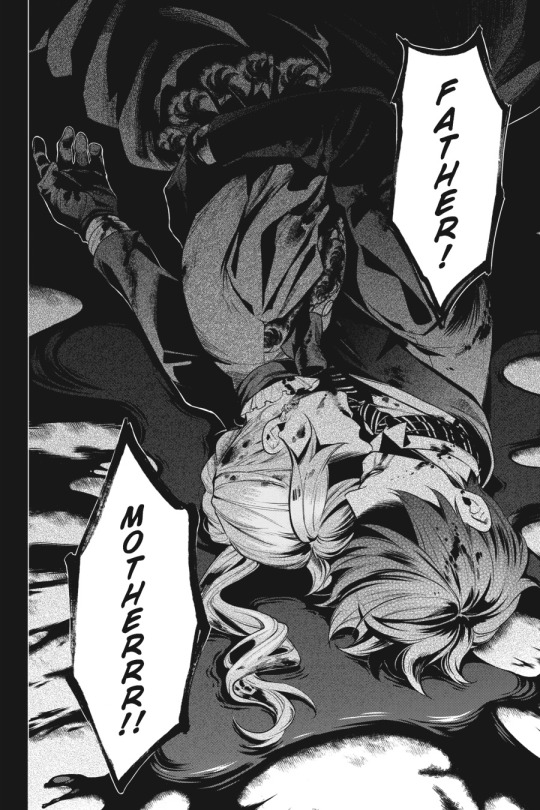
...even more emotional to me, since Rachel probably died trying to protect Vincent. T_T
TL;DR that's the Fenian Brotherhood theory: because they supported an Irish rebellious group that wanted freedom, Vincent & Rachel were branded political enemies of Victoria and she & JB plotted their deaths, which led in happenstance to the RCMT.


(friendly reminder that the twins are 7, when Vincent asked Dee to look after them should he die)
I hope it was clear ! Thanks for reading. :))
#kuroshitsuji#vincent phantomhive#ciel phantomhive#rachel phantomhive#angelina durless#madam red#cedric k. ros#finnian#kuro132#fenian brotherhood theory#ciel's real name#kuroshitsuji theory#dorkshadows#my analysis#blue memory arc
226 notes
·
View notes
Text
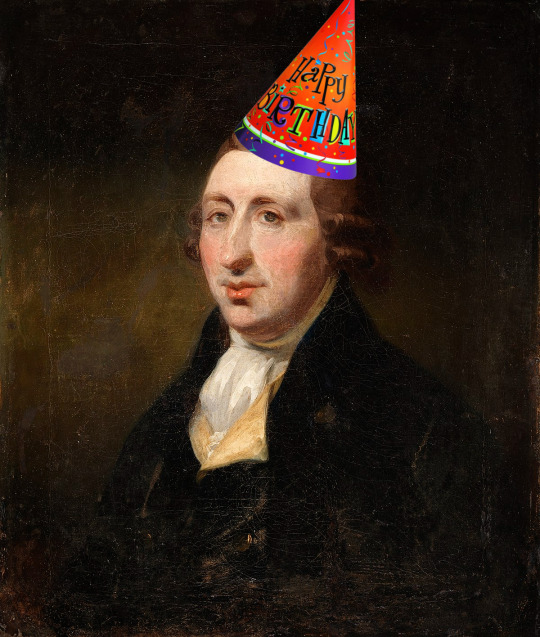
Happy birthday, Napper Tandy! (February 16, 1739)
A folk hero in Ireland, James Napper Tandy was born in Dublin to a merchant family. He was a political reformist who turned to revolution in order to secure Irish independence from British control. He was influenced by the French Revolution, and his activities and popularity led to attempted suppression by the government. He founded the Society of United Irishmen, a revolutionary organization, and planned a rebellion in exile with French support. In 1798 he returned to Ireland but was arrested after his revolution failed to occur. He was imprisoned until 1801, after which he was exiled once again to France, after Napoleon intervened in his case. He died in 1803, never again setting foot in Ireland.
140 notes
·
View notes
Note
Pairing: FrUK
Title: At the crossroads
(Sorry I am NOT creative at all)
Anon, I love you, I am kissing you on the mouth.
Send Me A Title And A Pairing And I Will Write The Summary Of A Fic I'll Never Write
In fact, anon, I love you so much you're getting twice the content, canonverse version and one LFLS version, which is my main AU (Like Father Like Son)
#1: From the Norman Invasion over key precipitious points in the Hundred Years War over France's not-very-successful attempts to help out Irish factions in Rebelling (Willamite Wars and United Irishmen Rebellion, anyone), the Napoleonic Wars, France's defeat in 1871, the Entente and finally to 1945 - This fic would examine a handful of crossroads that had England's and France's future up in the air and them re-examining their relationship.
#2: From rebellious Teenager lovers to two gangster bosses making their bones, this fic would examine François' courtship of Arthur and Arthur trying to figure out how he wants to combine what the heart wants with what the head knows to be right. Once T(w)eenage lovers, their relationship had considerably cooled after Arthur's father died and he entered the sharktank of Europe's underground. When François makes his own first clumsy steps at powerplay with the help of the equally green behind the ears Sicilian Michele, he and Arthur find themselves on opposite sides. However - This intrigues François' all the more and after he saved his skin by throwing Michele under the bus, which was by far not the first deathnail for their disastrous affair, he is on the prowl for a new adventure - And cracking Arthur, who's trying to fill his father's shoes, sounds just like the past time for him.
#beareplies#anon#aph#hetalia#hws#aph fruk#hws fruk#fruk#storie nostre#aph england#hws england#aph france#hws france#sorry if version 2 doesn't make sense it makes sense. To me. I will gladly explain the timeline and necessary AU worldbuilding to make it#make sense though
7 notes
·
View notes
Text
Maidin Luain Cincíse
“Maidin Luain Cinchíse” is one of my favourite Irish songs. It was written by the Munster poet Mícheál Óg Ó Longáin (1766-1837). Earlier Irish poets tended to be supporters of Jacobitism; however, Ó Longáin was a staunch republican, and even served as a messenger in the United Irishmen. The song, which laments the failure of the 1798 uprising, likely draws from his own personal experiences. Ó Longáin’s disappointment at the failure of his home province to rise is also expressed. I feel that this closeness to the writer is what makes the song so powerful.
“Maidin Luain Cincíse” means “Whit Monday Morning”, and refers to the Monday after Pentecost Sunday (usually referred to in England and Ireland as “Whit Sunday” or “Whitsun”). If I’m correct, I believe this would have fallen on May 28th in 1798. On that day in Wexford, the rebels successfully captured the garrison town of Enniscorthy. I’m not sure why this date is mentioned, as the song is lamenting defeat rather than victory. The language used seems to describe a rural rather than urban battle, too. I don’t know where Ó Longáin fought during the rebellion, and this would be key to understanding the exact situation he references. If anyone could help me check the date, or find the exact battle described, I would be most grateful! The mention of Whit Monday may also contrast the active state of the rebellion with that of Munster. The only major rebel action in Munster did not occur until the Battle of the Big Cross, on June 19th.
This version, sung by Aoife Granville (a folklore lecturer at my university) is the one I’ll translate. It’s considerably shorter than the texts I’ve found elsewhere. In places, different words are substituted. I think its arrangement is beautiful. It has an expressive quality that other versions I’ve found lack.
Maidin Luain Cincíse, labhair an síofra sa ghleann.
Do bhailíodar na cága chun ábhacht a dhéanamh ann
Do chruinníomar na dtimpeall, ‘s do lasamar ár dtinte
‘S do thógamar ceo draíochta go haoibhinn os a gcionn.
Cá bhfuilid na Muimhnigh nó an fíor go mairid beo,
Ná cruinníd siad ‘nár dtimpeall is cabhrú linn sa ngleo?
Mar is deacair poirt do stríocadh ná clann búir do dhíbirt
Ónár mbailte dúchais dílis bhí ár sinsir riamh fadó...
Pentecost Monday morning, the síofra spoke in the valley.
The jackdaws assembled, to make their fun there.
We gathered around, and we lit our fires
And we took a magic mist, blissful, overhead.
Where are the Munstermen, or the living image,
Won’t they come into our midst and help us in the fight?
For it’s difficult to strike port, or drive out the boorish clan,
From the sweet, native towns our ancestors held long ago.
A particularly sad verse, not in this version:
Beir scéala suas chun Mumhan uainn, a rún ghil ‘s a stór,
Agus inis an scéal faoi chumha dóibh go bhfuil an sciúirse ‘nár gcomhair;
Mar is mó leanbh fireann fionn geal agus ainnir mhilis mhúinte
Agus ógfhear cliste lúfar san úir uainn ag feo.
Bear a story from us up to Munster, bright darling, treasure,
And tell the lonely tale to them that the scourge is among us
For there are many fair bright manly lads, and sweet schooled maidens,
And agile clever young men, rotting in the earth.
4 notes
·
View notes
Text
Events 2.21
452 or 453 – Severianus, Bishop of Scythopolis, is martyred in Palestine.
1245 – Thomas, the first known Bishop of Finland, is granted resignation after confessing to torture and forgery.
1440 – The Prussian Confederation is formed.
1613 – Mikhail I is unanimously elected Tsar by a national assembly, beginning the Romanov dynasty of Imperial Russia.
1797 – A force of 1,400 French soldiers invaded Britain at Fishguard in support of the Society of United Irishmen. They were defeated by 500 British reservists.
1804 – The first self-propelling steam locomotive makes its outing at the Pen-y-Darren Ironworks in Wales.
1808 – Without a previous declaration of war, Russian troops cross the border to Sweden at Abborfors in eastern Finland, thus beginning the Finnish War, in which Sweden will lose the eastern half of the country (i.e. Finland) to Russia.
1828 – Initial issue of the Cherokee Phoenix is the first periodical to use the Cherokee syllabary invented by Sequoyah.
1842 – John Greenough is granted the first U.S. patent for the sewing machine.
1848 – Karl Marx and Friedrich Engels publish The Communist Manifesto.
1862 – American Civil War: Battle of Valverde is fought near Fort Craig in New Mexico Territory.
1866 – Lucy Hobbs Taylor becomes the first American woman to graduate from dental school.
1874 – The Oakland Daily Tribune publishes its first edition.
1878 – The first telephone directory is issued in New Haven, Connecticut.
1885 – The newly completed Washington Monument is dedicated.
1896 – An Englishman raised in Australia, Bob Fitzsimmons, fought an Irishman, Peter Maher, in an American promoted event which technically took place in Mexico, winning the 1896 World Heavyweight Championship in boxing.
1913 – Ioannina is incorporated into the Greek state after the Balkan Wars.
1916 – World War I: In France, the Battle of Verdun begins.
1918 – The last Carolina parakeet dies in captivity at the Cincinnati Zoo.
1919 – German socialist Kurt Eisner is assassinated. His death results in the establishment of the Bavarian Soviet Republic and parliament and government fleeing Munich, Germany.
1921 – Constituent Assembly of the Democratic Republic of Georgia adopts the country's first constitution.
1921 – Rezā Shāh takes control of Tehran during a successful coup.
1925 – The New Yorker publishes its first issue.
1929 – In the first battle of the Warlord Rebellion in northeastern Shandong against the Nationalist government of China, a 24,000-strong rebel force led by Zhang Zongchang was defeated at Zhifu by 7,000 NRA troops.
1934 – Augusto Sandino is executed.
1937 – The League of Nations bans foreign national "volunteers" in the Spanish Civil War.
1945 – World War II: During the Battle of Iwo Jima, Japanese kamikaze planes sink the escort carrier USS Bismarck Sea and damage the USS Saratoga.
1945 – World War II: the Brazilian Expeditionary Force defeat the German forces in the Battle of Monte Castello on the Italian front.
1947 – In New York City, Edwin Land demonstrates the first "instant camera", the Polaroid Land Camera, to a meeting of the Optical Society of America.
1948 – NASCAR is incorporated.
1952 – The British government, under Winston Churchill, abolishes identity cards in the UK to "set the people free".
1952 – The Bengali Language Movement protests occur at the University of Dhaka in East Pakistan (now Bangladesh).
1958 – The CND symbol, aka peace symbol, commissioned by the Direct Action Committee in protest against the Atomic Weapons Research Establishment, is designed and completed by Gerald Holtom.
1965 – Malcolm X is gunned down while giving a speech at the Audubon Ballroom in Harlem.
1971 – The Convention on Psychotropic Substances is signed at Vienna.
1972 – United States President Richard Nixon visits China to normalize Sino-American relations.
1972 – The Soviet unmanned spaceship Luna 20 lands on the Moon.
1973 – Over the Sinai Desert, Israeli fighter aircraft shoot down Libyan Arab Airlines Flight 114 jet killing 108 people.
1974 – The last Israeli soldiers leave the west bank of the Suez Canal pursuant to a truce with Egypt.
1975 – Watergate scandal: Former United States Attorney General John N. Mitchell and former White House aides H. R. Haldeman and John Ehrlichman are sentenced to prison.
1994 – Aldrich Ames is arrested by the Federal Bureau of Investigation for selling national secrets to the Soviet Union in Arlington County, Virginia.
1995 – Steve Fossett lands in Leader, Saskatchewan, Canada becoming the first person to make a solo flight across the Pacific Ocean in a balloon.
2013 – At least 17 people are killed and 119 injured following several bombings in the Indian city of Hyderabad.
2022 – In the Russo-Ukrainian crisis Russian President Vladimir Putin declares the Luhansk People's Republic and Donetsk People's Republic as independent from Ukraine, and moves troops into the region. The action is condemned by the United Nations.
2 notes
·
View notes
Text
Why We Wear Green on St. Patrick’s Day
Dressing in Green on St. Patrick's Can Trace Its Roots to Leprechaun Legends, as Well as a Sign of Irish Defiance.
— By Patrick J. Kiger | March 11, 2024

Photograph By Kirill Liv/Getty Images
Each year on St. Patrick’s Day, tens of thousands of Americans add green to their outfits, even if they can’t trace their ancestry back to the Emerald Isle. But most of those who wear green probably don’t realize that the color has only a tenuous connection to St. Patrick, and actually originated as a symbol of rebellious Irish nationalism.
Avoiding a Leprechaun's Pinch?
One legend suggests that wearing green on St. Patric’s Day makes the wearer invisible to leprechauns. The tiny red-bearded fairies of Irish folklore supposedly roam around pinching those who’ve chosen clothing of another hue.
But fear of leprechauns as a reason to wear green may be American rather than Irish in origin, explains Elizabeth Stack, a native of Ireland who is now executive director of the American Irish Historical Society in New York.
“No one in Ireland is worried that they will be pinched if they don't wear green,” Stack explains. Moreover, she notes, the mischievous mythical creatures don’t actually have anything to do with the feast day of Ireland’s patron saint, who is credited with spreading Christianity on the island in the Fifth Century, in part by blending its rituals with customs of the ancient Celtic pagan religion. (March 17 is the day that St. Patrick is believed to have died, somewhere around A.D. 460)
For that matter, green isn’t a color that has much of a connection to St. Patrick, either. “The earliest depictions of St. Patrick show him clothed in blue garments,” Stack says.
English Designated Blue for St. Patrick
But during the centuries that Ireland was ruled by the English, the color blue fell into disfavor among the Irish. Henry VIII, who declared himself king of Ireland in 1541, gave Ireland a coat of arms that depicted a golden harp, a traditional symbol of the nation, on a blue background. In the late 1700s, the association between blue and St. Patrick was further tainted for the Irish when the English king George III created a new order of chivalry, the Order of St. Patrick. “Its official color was a sky blue, known as St. Patrick’s blue,” Stack says.
By then, the ever-rebellious Irish had chosen a different hue to symbolize their country. They seized upon green, the color of the shamrock, which in legend St. Patrick used when he explained Christian beliefs to the Irish.
The custom of wearing green “may have come from the tradition of wearing a piece of shamrock on the day in Ireland,” Stack explains. “The significance of the three-leafed shamrock comes from St. Patrick himself. He used the shamrock to describe the three forms of God—the Father, Son and the Holy Spirit—to convert early Irish people to Christianity.”
Green as Sign of Irish Defiance
In the Great Irish Rebellion of 1641, Irish military leader Owen Roe O’Neill’s sailing vessels flew a flag that depicted an Irish harp on a field of green instead of blue, according to Jerrold Casway’s 1984 biography of O’Neill. Even after that uprising was crushed, Thomas Dineley, an Englishman who traveled through Ireland in 1681, “reported people wearing crosses of green ribbon in their hats on Saint Patrick's Day,” Stack says.
In the late 1700s, the Society of United Irishmen, an underground nationalist group that sought to emulate the American Revolution and overthrow English rule, used the color green as a symbol of their cause. To avoid being spotted by the English, a nationalist revolutionary might wear a subtle hint of green, such as a green feather in his cap, according to Robert Kee’s book The Green Flag: A History of Irish Nationalism.
Though the poorly-armed rebels were crushed by the British, the idea of wearing shamrocks attached to hats and the color green as nationalist symbols persisted, despite English attempts to suppress them. As described in Paul F. State’s book A Brief History of Ireland, “The Wearin’ o’ The Green,” a street ballad written by an anonymous songwriter around 1798, conveyed that rebellious meaning:
When law can stop the blades of grass from growing as they grow;
And when the leaves in summertime their verdure dare not show;
Then I will change the colour that I wear in my caubeen (hat),
But until that day, please God, I’ll stick to wearin’ o’ the green
As Irish immigrants arrived in the United States and other countries in the 1800s, they took the custom of wearing green with them, and it became a prominent feature of the boisterous St. Patrick’s Day parades staged in many cities. In the U.S., Canada, and Australia, where Irish newcomers were often regarded with suspicion, “St. Patrick's Day often performed the function of declaring, almost belligerently, the presence of the Irish among their host community,” Mike Cronin and Daryl Adair write in their history of holiday, The Wearing of the Green.
By the 1930s, the custom of wearing green on St. Patrick’s Day had become so widespread that even President Franklin D. Roosevelt, who was of Dutch ancestry, joined in. An article published on March 17, 1933 described how FDR teased Sen. F. Ryan Duffy of Wisconsin “when he appeared on St. Patrick’s Day wearing a blue tie and no sign of green.” Roosevelt himself wore a green carnation.
The custom has become so established in the U.S. that, according to the National Retail Federation, 82 percent of those who celebrate St. Patrick’s Day mark the holiday by proudly wearing green.
— Leprechaun. Noun. Lep·re·chaun ˈlep-rə-ˌkän. -ˌkȯn.: A Mischievous elf of Irish Folklore that Some Believe will Reveal Where Treasure is Hidden If Caught.
#St. Patrick’s Day ☘️#Wearing Green#Trace | Roots | Leprechaun ☘️ 🍀 Legends#Sign of Irish ☘️ Defiance#Leprechaun’s 🍀 ☘️ s Pinch 🤏#English 🇬🇧 | Designated | Blue For St. Patrick
0 notes
Text
A Useful Englishman
#Thomas #Paine #Monarchy
One of the greatest mistakes made by the British establishment was to consider the Irish stupid. Arthur O’Connor, a member of the United Irishmen and later a General in Napoleon’s army, when arrested on the eve of the Irish Rebellion of 1798, distributed the below poem before being led away to prison:
The pomp of courts and pride of kings
I prize above all earthly things;
I love my country;…
View On WordPress
0 notes
Text
Kilmainham Gaol
Kilmainham Gaol is one of the largest unoccupied gaols in Europe, covering some of the most heroic and tragic events in Ireland’s emergence as a modern nation from the 1780s to the 1920s. Attractions include a major exhibition detailing the political and penal history of the prison and its restoration.
Located approximately two miles outside of Dublin city centre, it was built as a county gaol to…
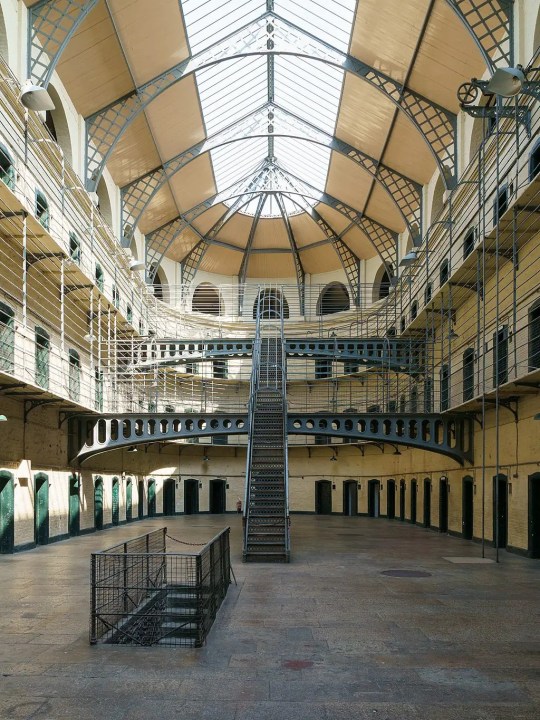
View On WordPress
#1798 United Irishmen Rebellion#1916 Easter Rising#Dublin#History#History of Ireland#Ireland#Irish Civil War#Irish History#Irish War of Independence#Kilmainham Courthouse#Kilmainham Gaol#Office of Public Works#OPW#Thomas Francis Meagher
27 notes
·
View notes
Text
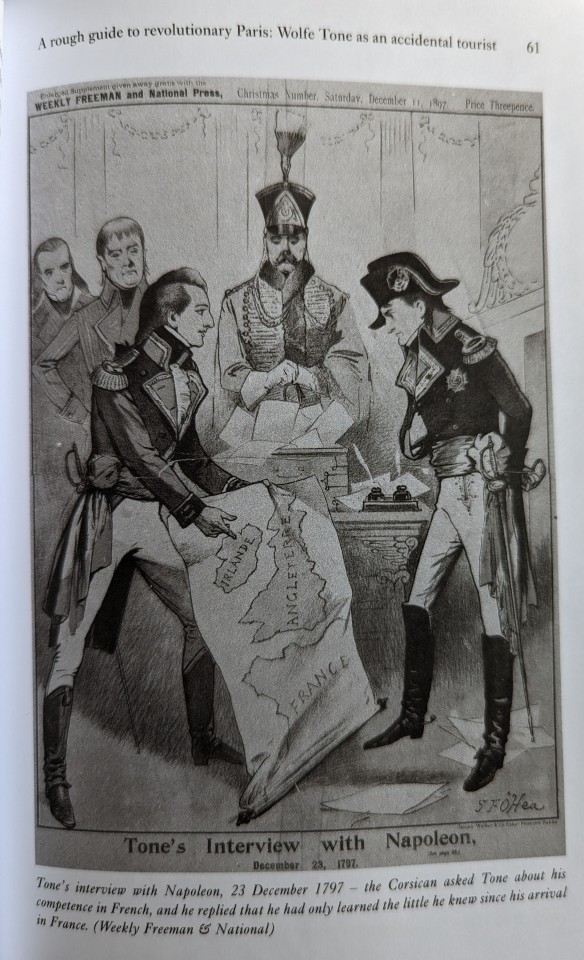
Look at this drawing of Wolfe Tone and Napoleon from 1807
202 notes
·
View notes
Text
1798–Battle of Carlow
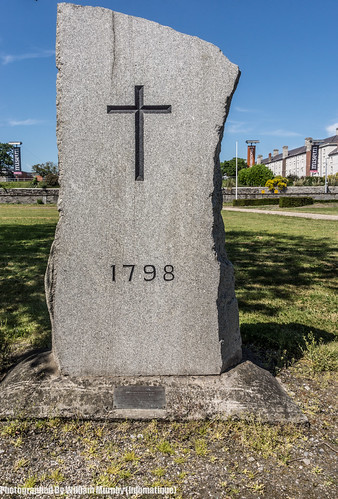


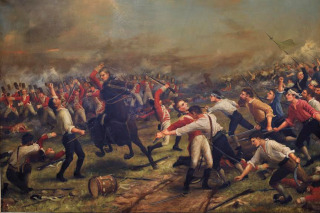

Battle of Carlow begins; executions of suspected rebels at Carnew and at Dunlavin Green take place.
0 notes
Text
Irish/German line
While researching my Irish and German familial lines:
from my grandfather’s father, Edwin Carpenter - Rose Maria Snook (his mother) - William John Snook 1811-1884 (her father) - Esther Gillian 1783-1846 (his mother) - William Gillian 1753-1792 and Katherine Minser 1761-1792
I found this intriguing story:
“William Gillian of Stronoken Bridge, Antrim, Ireland, came to America about 1773, having participated in a rebellion against the English, fled from his home and came to the American Colonies, leaving his wife and daughter. Either deliberately, or believing his wife dead, because of the uncertainty of communication, he married an American girl, Katherine Minser. They had six children. His first wife was Sarah Dunshee.
One evening two callers appeared at his home--a woman, whom he introduced as his cousin from Ireland, and her daughter. The "cousin" talked most of the night, and something aroused the American wife's suspicion. Upon confronting them in the morning, she learned the truth--the "cousin" was in reality his wife, so she left, taking her children with her.
The oldest one, Amy, was adopted, taken west, and lost sight of. John Riheldaffer, a son of Katherine, was a minister in St. Paul, Minn. Phoebe and her husband George Stuck, are buried in Evergreen Cemetery (Fairfield, Iowa) beside Casper and Esther Snook.
The Irish wife went back to him and they had another daughter, Sarah, so that the oldest and youngest children were children of the Irish wife.
William Gillian married in Ireland, Sarah Dunshee, and had a daughter born before 1773.”
Not immediately trusting William Gillian’s story of participating in a rebellion against the English, as he had lied to his wife, my 5th great-grandmother, and upon initial searching could not find an Irish rebellion taking place in the approximate time period I eventually stumbled upon this:
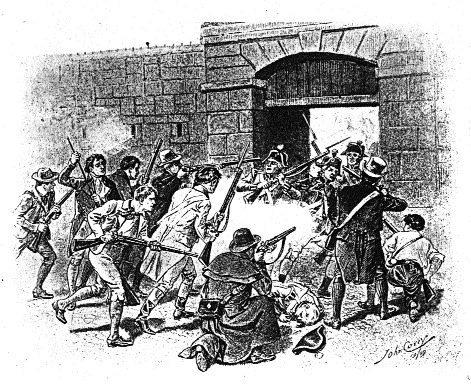
“In the 1770s, twenty years before the United Irishmen, there occurred an armed rising by the poor people of Ulster, mainly Presbyterians, against injustice and oppression. The rising was to last almost four years. It witnessed assemblies of armed men, the storming of towns and even battles. Writing a hundred years later, W.E.H. Lecky described it as a ‘formidable insurrection’. To many at the time it seemed that society was about to be overthrown and even the influx of large numbers of troops into the area did not immediately put an end to it.
The alarm engendered by this insurrection is clear in a letter from a landlord to Sir George Macartney, the Lord Lieutenant’s secretary:
I want proper words to convey adequate ideas to picture the danger I have reason to believe my own life, the lives of my family, and the utter destruction of my worldly substance is in, from an abon’d, illoyal, lawless, irreligious banditti who have armed themselves in this part of the country to the great terror of every of his majesties liege subjects, and more especially to those of them that enjoy any kind of property.
In the second half of the eighteenth century King George III and his government still lived in fear of a repeat of the 1745 Jacobite rebellion. However, this rising was started by poor tenants fearful of eviction.
Donegall’s debts
In 1769 the fifth Earl of Donegall was among the largest landowner in Ireland. His estates were counted in thousands of acres. Even one of his tenants might lease as much as 7,000 acres, which would be sub-let to farmers in small plots. He also had estates in England and along with the title inherited the accumulated debts of his forefathers. Faced with large debts and expenses, the fifth earl needed to raise money badly. He decided to make his estates in Ulster financially viable. The plan was to replace the smaller tenants with more substantial ones so as to increase the rents and to charge fines for the granting of new leases. This overhaul began on lands held by the middleman, Clotworthy Upton, and was immediately opposed by the tenants there. These tenants banded together for mutual support, refusing to pay increased rents or to accept new leases. Their great fear was that the changes proposed by Lord Donegall would result in the eviction of hundreds of families. They carried out acts of violence against Clotworthy Upton and tenants who accepted new leases. As the re-organisation spread to lands held through other middlemen (as well as those held from Lord Donegall directly) so too did the violent protest. The rebellious tenants became more organised, forming recognisable groups under specific leaders. They became known as the ‘Hearts of Steel’, or ‘Steelboys’, and under this name carried on a campaign of protests and outrages for the next four years. Lord Donegall was not the only landlord who was attempting to improve his estates, nor the only one to give offence to his tenants, and so other tenants followed their example and formed Steelboy groups. Their grievances related not only to landholding but also to paying tithes to the established church and the county cess.”
There’s more to it as well, and it’s quite an interesting read, but judging by the time period given and where my grandfather, William Gillian was from it seems like a very strong possibility he was in fact a Steelboy and part of this uprising (Antrim, his birthplace is in the historical province of Ulster where this rebellion took place)
TLDR: Irish 5th great-grandfather was probably a poor tenant of a wealthy land-owning class, participated in revolution against them and their unfair rents and eventually expanded to include causes like unfair tithes (church tax essentially)
You can read more about the uprising here:
https://www.historyireland.com/illoyal-lawless-irreligious-banditti/#:~:text=In%20the%201770s%2C%20twenty%20years,of%20towns%20and%20even%20battles.
All in all, quite a neat find.
0 notes
Note
What did England do to Ireland?
Oh boy, it's more like what they didn't do anon. Sit back as you'll be reading for a while.
From the late 12th century, the Anglo-Norman invasion of Ireland resulted in Anglo-Norman control of much of Ireland, over which the kings of England then claimed sovereignty. By the late Late Middle Ages, Anglo-Norman control was limited to an area around Dublin known as the Pale.
Enacted in 1494, Poynings law ensured that the Irish parliament could not meet without the approval of England's monarch and Privy Council. In 1541, English king Henry VIII changed Ireland's status from a lordship to a kingdom, and he was proclaimed King of Ireland.
The United Irishmen Rebellion of 1798 (which sought to end British rule in Ireland) failed, and the 1800 Act of Union merged the Kingdom of Ireland into a combined United Kingdom of Great Britain and Ireland.
In the mid-19th century, the Great Famine (1845-1851) resulted in the death or emigration of over two million people. At the time, trade agreements were controlled by the British government and whilst millions were suffering from hunger, Irish harvests of wheat and dairy products were exported to Britain and other overseas territories.
A Home Rule Bill was passed in 1912 but not brought into law due to the outbreak of World War I in 1914. The Easter Rising of 1916 resulted in the execution of the rebellion's leaders. In the 1918 Irish general election, Sinn Féin won a majority of Irish seats and in 1919 these elected MPs declared the independence of the Irish Republic. The Irish War of Independence followed from 1919 to 1921. The Government of Ireland Act of 1920 and the Anglo-Irish Treaty of 1921 resulted in the formation of the Irish Free State, while Northern Ireland's MPs opted out to form Northern Ireland.
And this is just some of it
0 notes